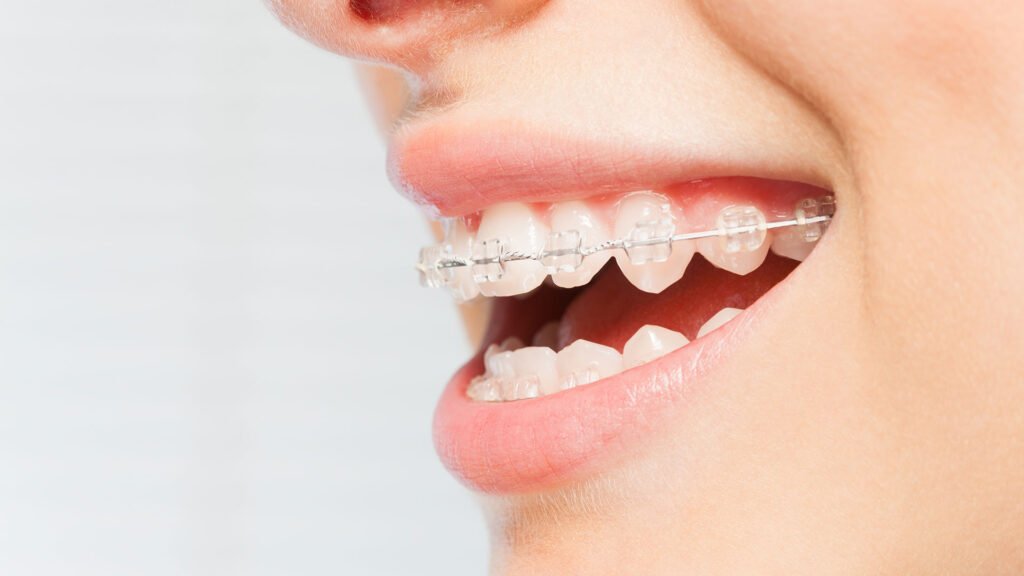Clear braces have become a popular choice for adults who want a more discreet option for correcting their smile. But how long can you expect clear braces to last? Are they as durable as their metal counterparts? Let’s explore the lifespan and durability of clear braces and discover what factors can influence their treatment time.
Key Takeaways:
- Clear braces can last anywhere from 12 to 36 months, depending on the individual’s orthodontic needs.
- Clear braces tend to take longer to straighten teeth compared to metal braces due to their fragility and increased friction during tooth movement.
- Factors such as age, the severity of the orthodontic condition, and patient compliance can influence the duration of clear braces treatment.
- Maintaining excellent oral hygiene and following the orthodontist’s instructions are crucial for successful treatment and the durability of clear braces.
- Consulting with a qualified orthodontist is essential for individuals to make an informed decision about their orthodontic treatment journey.
Understanding Clear Braces and Their Popularity
Clear braces are orthodontic appliances that use tooth-colored or clear brackets to blend in with the teeth. Made of polycrystalline alumina, clear braces are more subtle in appearance compared to traditional metal braces. They work similarly to metal braces, with brackets and archwires applying pressure to move the teeth into proper alignment.
Clear braces have gained popularity among adults and individuals who prioritize the aesthetic aspect of their orthodontic treatment. With their discreet appearance, clear braces appeal to those who desire a more inconspicuous option while straightening their teeth. The subtle and natural appearance of clear braces allows individuals to maintain their confidence throughout the treatment process.
Ceramic Braces: A Comprehensive Duration Analysis
Ceramic braces, a type of clear braces, are known for their discreet appearance. These braces blend in with the natural color of the teeth, making them less noticeable compared to traditional metal braces.
Treatment with ceramic braces usually lasts between 12 to 24 months. However, the duration can vary depending on several factors, including the individual’s specific orthodontic needs and the severity of their condition. Regular visits to the dentist to tighten the brackets and wires play a crucial role in achieving the desired results.
The movement of teeth during the treatment period is a gradual process. Tooth movement is controlled by the application of gentle and consistent force applied by the ceramic braces. The brackets and wires work together to exert pressure on the teeth, gradually shifting them into proper alignment.
Factors such as age, the severity of the orthodontic problem, and the patient’s compliance with oral maintenance and dental appointments can impact how long someone needs to wear ceramic braces. Younger patients typically experience faster results due to their developing jaws, while more severe orthodontic cases may require a longer treatment period.
It is important for patients to follow their orthodontist’s instructions and adhere to proper oral hygiene practices during the treatment period. This includes regular brushing and flossing, as well as attending scheduled dental appointments for adjustments and maintenance.
In summary, treatment with ceramic braces usually lasts between 12 to 24 months. The duration can vary depending on individual factors and the patient’s cooperation with the treatment plan. By following the orthodontist’s instructions and maintaining good oral hygiene, patients can help ensure a successful outcome and achieve the desired results.
Factors That Influence Treatment Time
Several factors can influence the duration of clear braces treatment. Age and orthodontic condition are two significant factors that can impact the treatment time.
Younger patients tend to see faster results with clear braces due to their developing jaws. This is because their teeth and bones are more responsive to orthodontic movements. As a result, the treatment time may be shorter for younger individuals.
The severity of the orthodontic condition also plays a role in determining the treatment duration. Minor spacing or crowding issues can often be corrected in about a year or less with clear braces. However, more severe cases may require a longer treatment period to achieve the desired results.
Patient compliance with oral hygiene and regular dental appointments is crucial for successful treatment. By following the orthodontist’s instructions and taking care of the braces as directed, individuals can contribute to a smooth and efficient treatment process. This includes proper brushing and flossing, as well as attending scheduled appointments for adjustments and check-ups.
By considering these factors and working closely with a qualified orthodontist, patients can have a better understanding of the estimated treatment time for their specific orthodontic condition.
Maintenance and Care for Clear Braces
Proper maintenance and care are essential for clear braces. It’s important to follow the orthodontist’s instructions for cleaning and caring for the braces to ensure their longevity and effectiveness.
One of the key aspects of maintaining clear braces is practicing good oral hygiene. Regular brushing and flossing are crucial to remove food particles and plaque that can build up around the braces and teeth. This helps prevent tooth decay and gum disease, which can be more challenging to address with braces in place.
Patients with clear braces should also be mindful of the foods they consume. Avoiding sticky and hard foods can help prevent damage to the braces. Additionally, certain foods and drinks, such as coffee and red wine, have the potential to stain the braces. Being cautious about consuming these items can help keep the braces looking their best.
Attending scheduled dental appointments for adjustments and maintenance is another important aspect of clear braces care. These appointments allow the orthodontist to monitor progress, make any necessary adjustments to the braces, and ensure that treatment is progressing as planned.
By following these maintenance and care guidelines, patients can maximize the effectiveness of their clear braces treatment and achieve the desired results in a timely manner.
Risks and Durability of Clear Braces
Clear braces are generally safe and effective, but like any orthodontic treatment, they do come with some risks and durability concerns. It’s important to understand these factors before deciding if clear braces are the right option for you.
One aspect to consider is the durability of clear braces compared to traditional metal braces. While clear braces are designed to be strong and resilient, they are slightly less durable than their metal counterparts. This means that they may be more susceptible to breakage or cracking, especially during activities that involve physical contact or sustained pressure, such as contact sports or public speaking engagements.
To maintain the durability of clear braces, patients wearing them should also be mindful of certain foods that can potentially damage the braces. Hard candies and sticky foods, for example, can exert excessive force on the braces and increase the risk of brackets or wires breaking. It is best to avoid these types of foods or consume them with caution to minimize the risk of damage.
Another aspect to be aware of is the potential for staining. The light coloring of clear braces makes them more prone to staining compared to metal braces. To reduce the risk of stains, it is recommended to avoid foods and drinks that are known to cause discoloration, such as coffee, tea, red wine, and certain strongly pigmented foods. Regular brushing and proper oral hygiene can also help mitigate the risk of staining and maintain the appearance of the braces throughout the treatment period.
Overall, taking proper care and following the orthodontist’s instructions are essential for preserving the durability of clear braces and minimizing the associated risks. Adhering to the recommended oral hygiene practices, being cautious about the foods you consume, and promptly addressing any issues or concerns with your orthodontist can help ensure a successful and problem-free treatment experience.
Comparing Clear Braces to Other Cosmetic Orthodontic Options
Clear braces provide individuals with a discreet and aesthetically pleasing alternative to other cosmetic orthodontic options. While the treatment duration for clear braces may be longer compared to metal braces, many patients find the superior aesthetics well worth the investment of a little extra time.
When considering teeth-straightening treatment options, it is essential to consult with an orthodontist who can provide expert guidance based on your specific needs. Clear aligners and lingual braces are alternative options that patients can explore during their consultation to determine the best choice for achieving a straighter smile.
Clear aligners, such as Invisalign, are custom-made, removable trays made from clear plastic. They gradually shift the teeth into the desired position. Clear aligners offer a nearly invisible treatment option, allowing patients to maintain their confidence throughout the teeth-straightening process.
Lingual braces, on the other hand, are similar to traditional metal braces but are placed on the backside of the teeth, making them virtually invisible from the front. Lingual braces can effectively correct a wide range of orthodontic issues while remaining discreet.
During your orthodontic consultation, your orthodontist will carefully evaluate your teeth and bite to determine which treatment option is most suitable for you. They will take into account factors such as the complexity of your orthodontic needs, treatment goals, and desired aesthetic outcome.
What to Expect During Your Orthodontic Consultation
When you schedule an orthodontic consultation for clear braces, you can expect a comprehensive evaluation from the orthodontist. They will thoroughly assess your teeth and bite to determine if clear braces are the right option for you. During the consultation, the orthodontist will discuss your treatment goals and preferences to gain a better understanding of your expectations.
The orthodontist may request X-rays or images of your teeth to assess their current condition and plan for the treatment. These images help them develop a personalized treatment plan tailored to your specific needs. By analyzing these images, the orthodontist can determine the precise movements and adjustments required to achieve your desired results.
During the consultation, the orthodontist will also discuss the expected treatment duration and provide you with a clear understanding of what to expect throughout the process. They will explain the maintenance and care instructions you should follow while wearing clear braces. This includes proper oral hygiene practices and avoiding certain foods and activities that could potentially damage the braces.
Additionally, the orthodontist will address any potential risks or limitations of clear braces, allowing you to make an informed decision about your treatment. They will answer any questions or concerns you may have, ensuring that you feel confident and well-informed before proceeding with clear braces.
Remember, the orthodontic consultation is an essential step in your orthodontic journey. It provides you with the opportunity to discuss your expectations, understand the treatment plan, and address any concerns you may have. By working closely with your orthodontist, you can achieve the desired results and enjoy a beautiful, straight smile.
Conclusion
Clear braces offer a discreet and aesthetically pleasing option for adults and individuals seeking orthodontic treatment. While they may require a slightly longer treatment duration compared to metal braces, the aesthetic advantages make clear braces a worthwhile investment. Proper maintenance and care, along with regular dental appointments, are crucial for the durability and success of clear braces.
Consulting with a qualified orthodontist is essential to make a confident and well-informed decision about teeth-straightening options. During the consultation, the orthodontist will discuss the treatment duration, maintenance requirements, and potential alternative orthodontic options. They will develop a personalized treatment plan based on individual needs and goals.
By considering factors such as treatment duration, maintenance, and alternative orthodontic options, individuals can choose the most suitable teeth-straightening treatment. Clear braces, when properly maintained and cared for, can help achieve the desired results, providing a straighter and more attractive smile.









